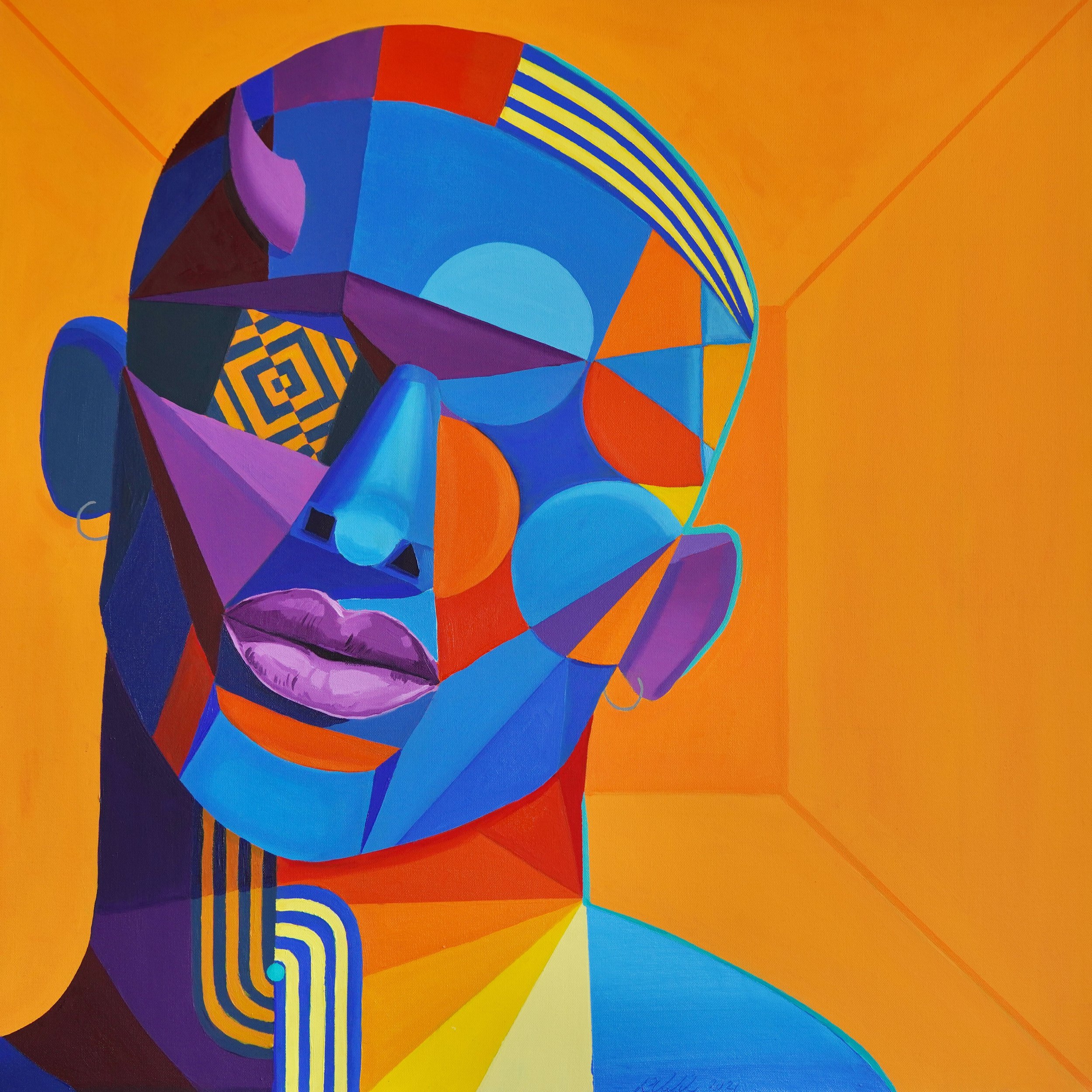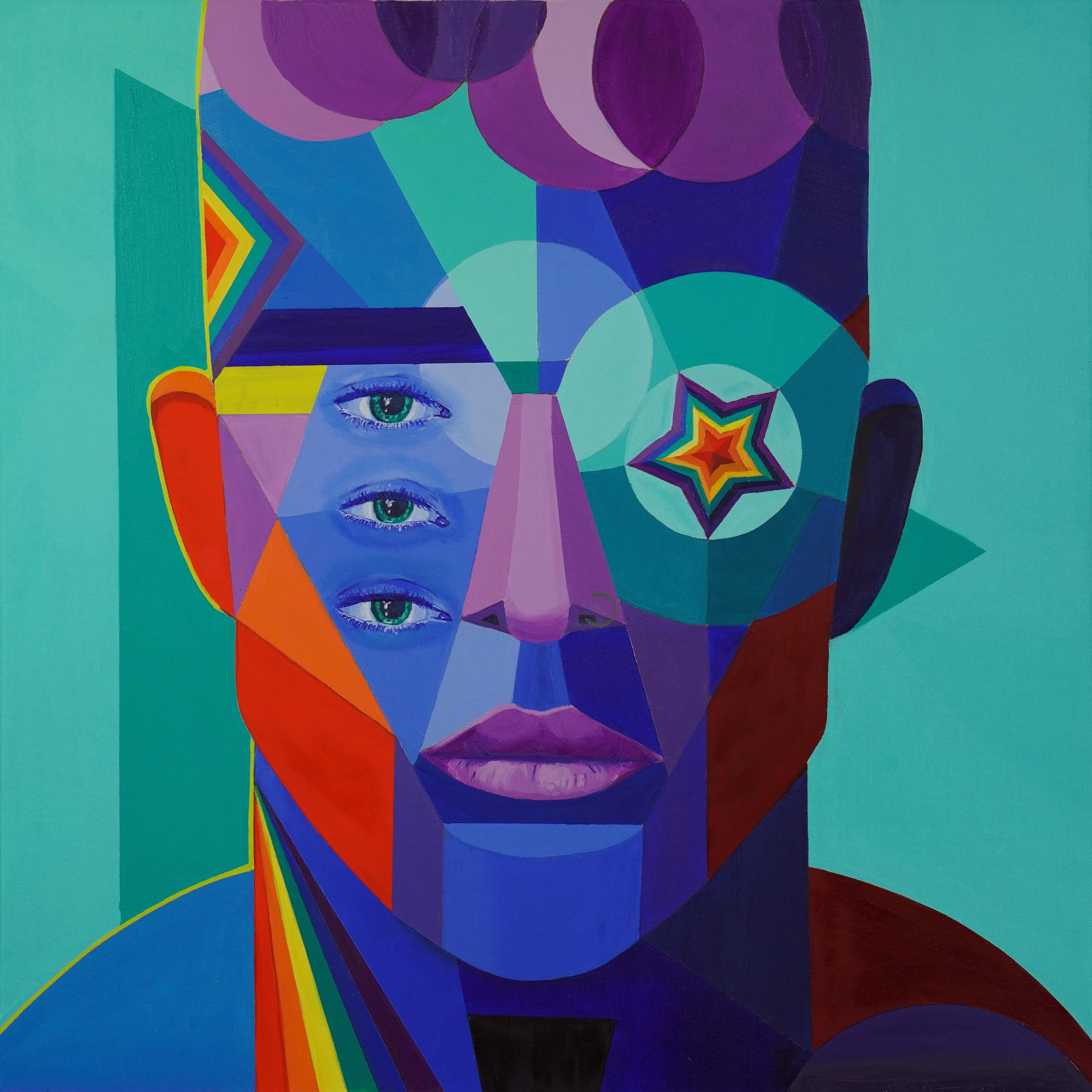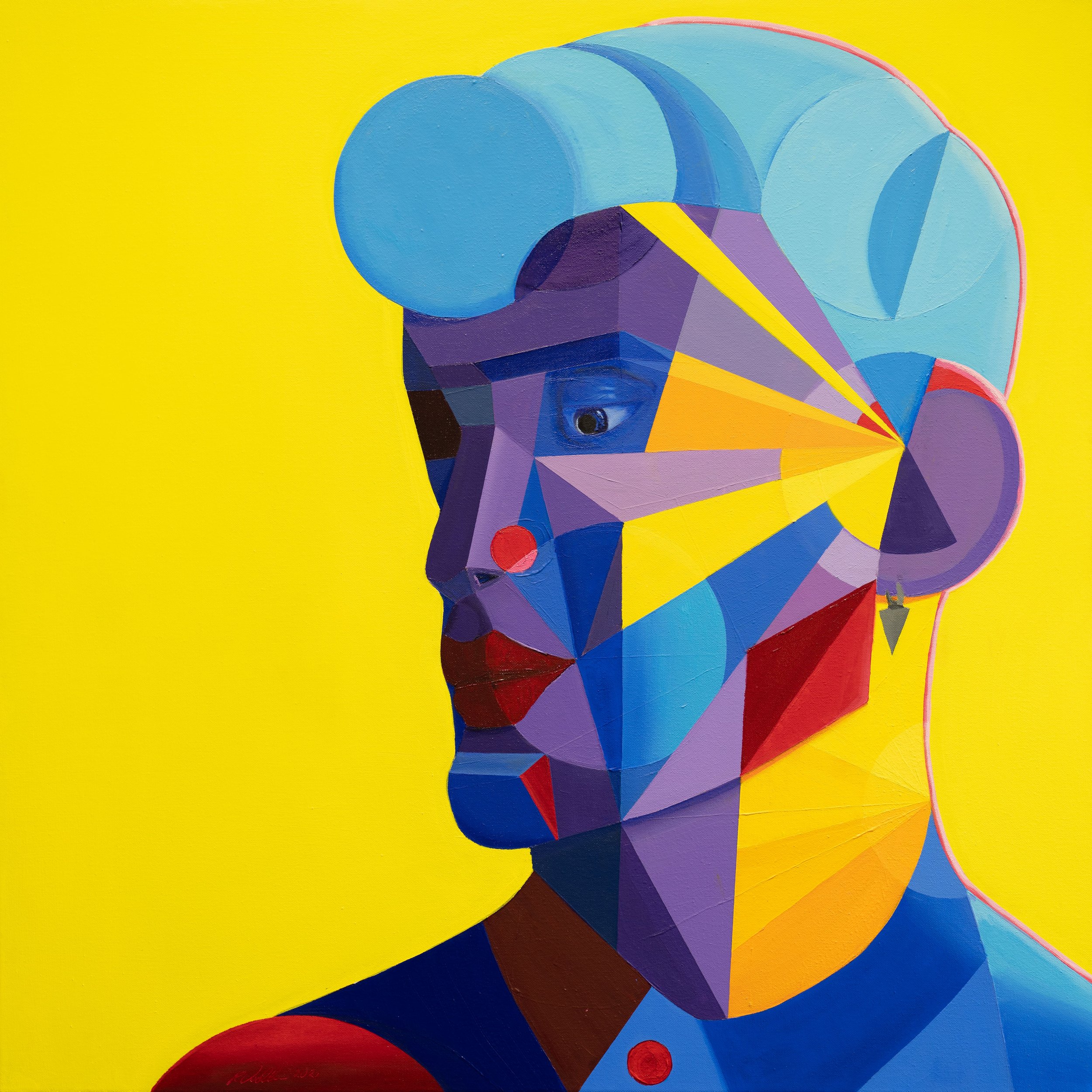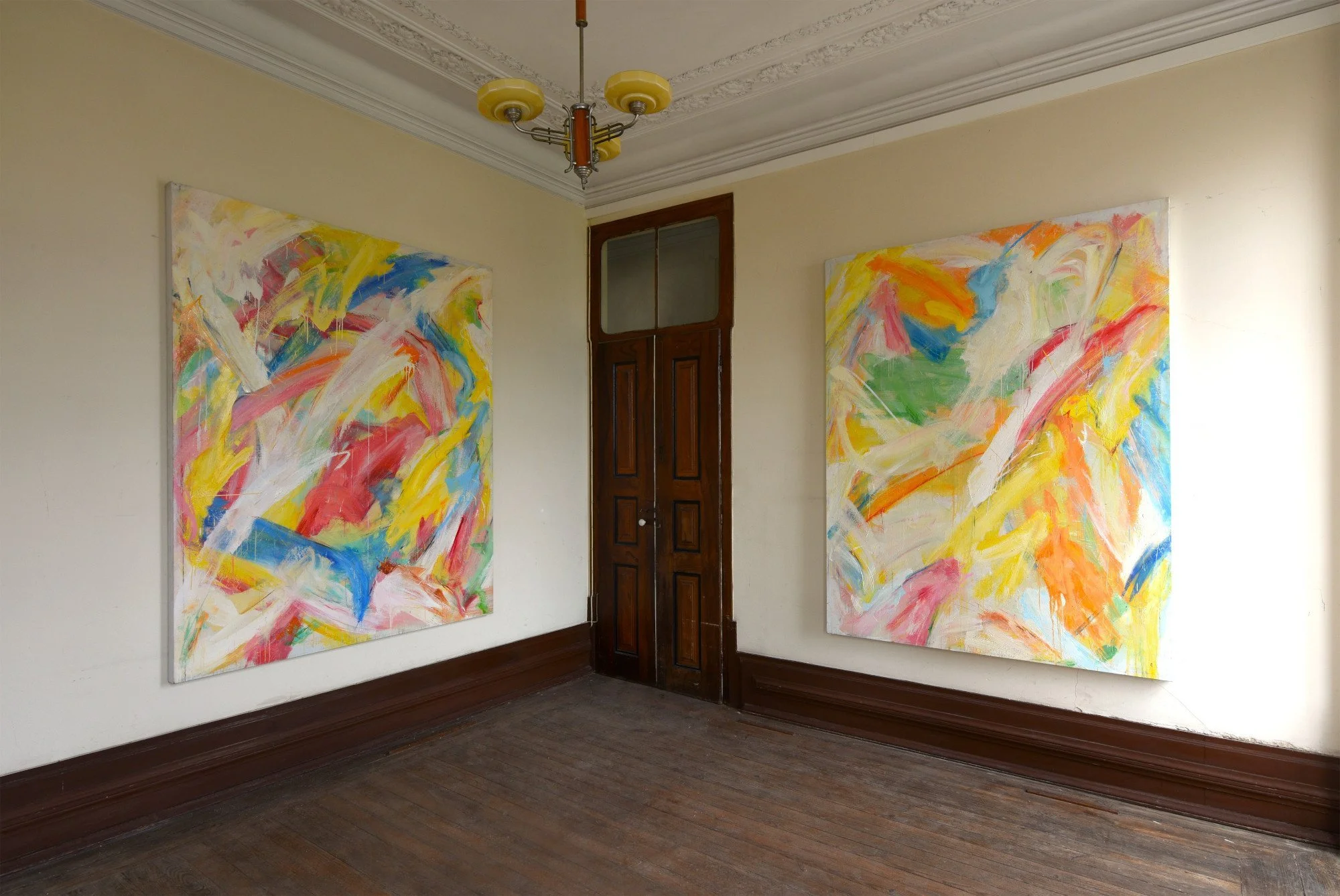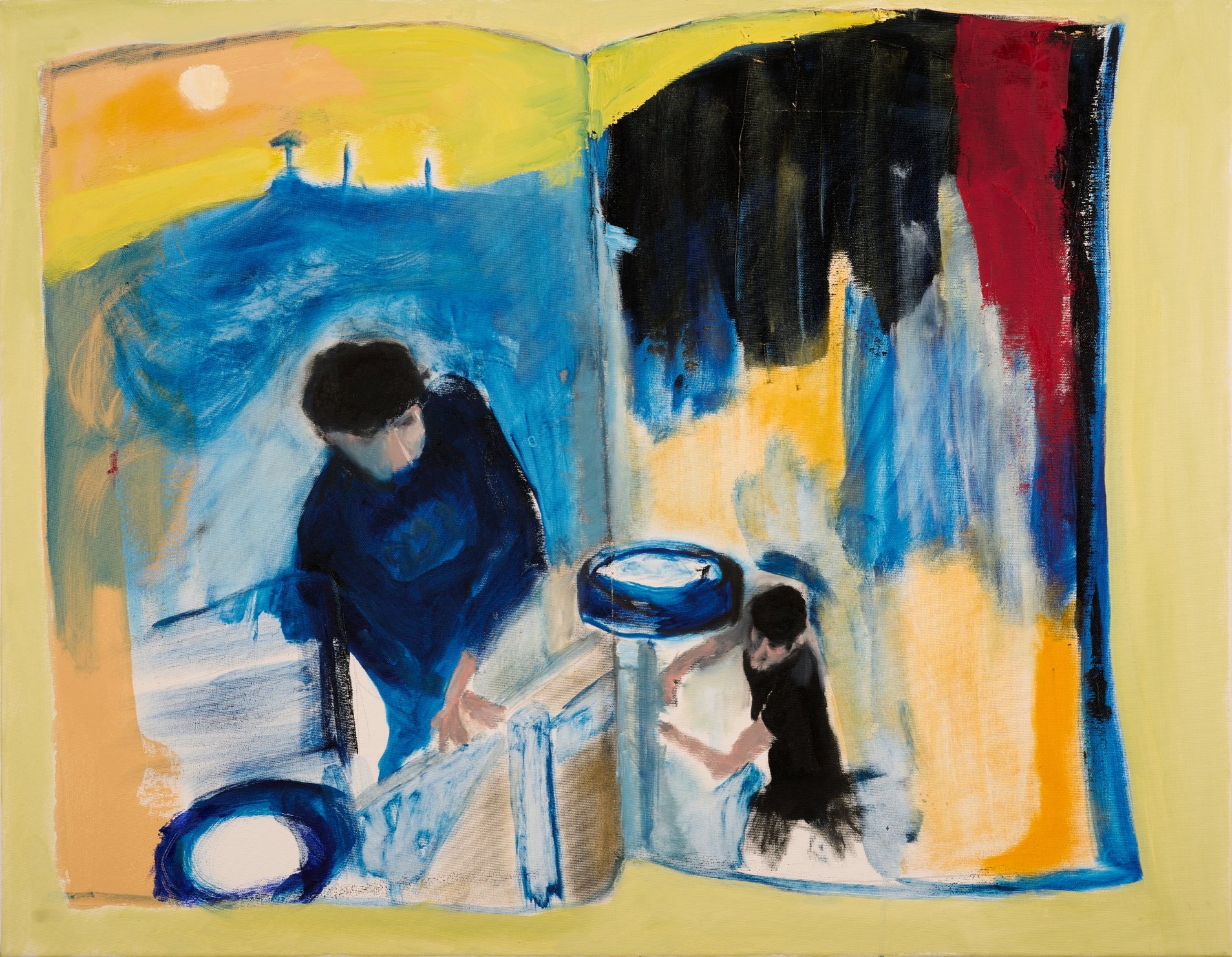10 Questions with Kohlben Vodden
A rising star in the British contemporary art scene, Kohlben Vodden is an Australian-born self-taught artist living and working in London, UK. His obsession with psychological concepts such as identity and aesthetics are central to his artistic practice, which currently manifests as boldly colourful abstracted portraits.
Through his practice, he explores stories that exist in the dissonance between how we internally define ourselves versus the version of ourselves we craft for the world to see.
A lifetime creative, since childhood he spent many years perfecting his artistic practice in figurative realism drawings. His evolution from amateur to professional artist began during the UK COVID-19 lockdowns in 2020 when he developed “Orange Ebby” – the first piece in his body of work exploring identity through abstract portraits. Vodden enjoys the juxtaposition of using traditional mediums such as oil paint in uncharacteristically controlled techniques to create intensely contemporary aesthetic images that could, at first glance, be considered digital in origin.
His work was quickly recognised across the UK and internationally and has been included in private and public exhibitions in Berlin, Brussels, London, Milan, and New York. Vodden’s unique take on the contemporary portrait has also caught the attention of fine art and culture publications, including British Vogue, Create! Magazine, Artist Talk Magazine, and Juturna Male Art Magazine.
Kohlben Vodden - Portrait in the studio (2022)
ARTIST STATEMENT
As an artist, Vodden paints like he lives his life - unapologetically original, authentically, intensely considered, divisively, and with an insatiable need for self-expression and direction.
Obsessed with psychology, he is particularly fascinated with the concept of identity and the stories that reveal themselves in the dissonance between a person's concept and their social image.
To reveal these hidden stories, he embarks on a deep process of connection, deconstruction, and reconstruction. Engaging directly with the subject, he explores their inward identity and outward social image. He then focuses on a meditative-like analysis of the face, identifying geometric shapes hidden to the casual observer. Finally, he reconstructs their image, creating a completely new story of their identity.
Working in oil with a masterful and bold colour palette, his work employs insights from Neuroaesthetics to command the eyes' attention and stimulate a combination of psychological 'rewards' including the release of dopamine, a chemical linked to sex and love, and the activation of the cultural region of the brain that seeks social meaning.
Green Che, Oil on Canvas, 90x90 cm, 2022 © Kohlben Vodden
Get your limited edition copy now
INTERVIEW
First of all, tell us something more about you. Who is Kohlben Vodden? If you had just three words, how would you describe yourself?
As an artist, I paint like I live my life. Unapologetically original, authentically, intensely considered, and with an insatiable need for self-expression. What you see in my art is an expression of who I am as a person. If I had to describe myself in just three words, they would be curious, brave, and passionate.
You just recently started working as an artist during the Covid-19 lockdowns. What is your background, and what did you do before becoming an artist?
I'm a lifelong creative. Throughout my childhood and into adulthood, I obsessed with perfecting figurative realism drawings in charcoal and graphite. This is something I did on and off while pursuing a career in advertising and lecturing on psychology in marketing, until the Covid-19 lockdowns in London. I used the lockdowns as a catalyst for change. I explored and developed a completely new abstract creative style that really pushed me out of my realism comfort zone. After creating "Orange Ebby", my first abstracted geometric portrait, I knew that oil painting was my passion and something I had to explore professionally.
Orange Ebby, Oil on Canvas, 90x90 cm, 2021 © Kohlben Vodden
What do you wish you knew about contemporary art before you got started?
The absolutely necessary amount of work that isn't directly related to your creative practice. For example, building and growing your artist profile online, photographing your work, managing exhibitions, and building relationships with galleries and collectors. To be successful in the contemporary art world, you need to invest 50% of your time in the business side.
Can you tell us about the process of creating your work? What aspect of your work do you pay particular attention to?
Through my practice, I explore stories that reveal themselves in the dissonance between a person's personal concept and their social image. To reveal the hidden stories, I embark on a deep process of connection, deconstruction, and reconstruction. To connect, I engage directly with the subject, asking questions about how they define their inward identity. I then explore their outward image, such as the physical features others believe define the subject. Enlightened with these psychological insights, I use them to fuel a deconstruction process of the subject's image. Engaging in a deep meditative-like analysis of the face, I identify geometric shapes, symbols, and patterns hidden to the casual observer. Finally, I reconstruct their image, creating a completely new visual story of their identity.
When creating a new painting, I focus most on discovering and sharing a visual story about the subject - a story that portrays their self-concept, their social image, and the rich world that exists between the two.
Blue Paul-Emile, Oil on Canvas, 90x90 cm, 2021 © Kohlben Vodden
Mint Max, Oil on Canvas, 90x90 cm, 2021 © Kohlben Vodden
Your works are bold and colorful. How did you come up with this way of creating your works? Do the colors you choose have any specific meaning for you?
My work employs insights from Neuroaesthetics, an experimental psychology field, exploring how our brains experience beauty. I use these psychological principles to command the eyes' attention and intentionally stimulate an unusual combination of psychological 'rewards' including a release of dopamine, a chemical linked to feelings of sex and love, and the activation of the cultural region of the brain that seeks patterns, shapes, and other visual attributes that give it 'meaning' and make them feel more connected to the piece.
Humans are visually dominant, and colour has so much power over us. It has the ability to affect our emotions and convey cultural meaning. I was immersed in the world of colour psychology long before I learned about colour field techniques. Each painting is based on a colour that the subject/muse has told me they most identify with. I then build a colour palette around this colour. This approach is a lot more intellectually challenging than giving myself permission to direct the palette. My mind is hardwired for problem-solving, so this method of giving power to the subject creates a problem that my brain gets excited about solving.
In your portraits, you often deal with the concepts of psychology and identity. How do you incorporate such themes in your paintings?
I'm obsessed with psychology. I'm particularly fascinated with the concept of identity, and its layers of complexity. Through my practice, I explore the dissonance between how a person's personal concept and their social image diverge and the stories that exist within that gap. These often hidden stories are expressed in my paintings through colour, symbolism, and shapes.
What is the most challenging part of your work? And where do you find your inspiration?
My entire process is creatively challenging, and that's why I love it. My inspiration comes from working with human subjects with interesting stories to tell. This can be a unique visual appearance, someone who is an agent of change in the world or someone who is underrepresented.
Red Sebastian, Oil on Canvas, 90x90 cm, 2021 © Kohlben Vodden
Yellow Ryan, Oil on Canvas, 90x90 cm, 2022 © Kohlben Vodden
What are your thoughts on digital presentations, like fairs and exhibitions, for artists? Do you think these are good opportunities?
I believe virtual fairs and exhibitions are great for artists wanting to grow their profile/cv and increase awareness of their work. They can also offer a chance to be exhibited with international galleries without the prohibitive shipping costs. However, this comes with a big caveat. Digital art world experiences are in their infancy and, as such, aren't places trusted by collectors to conduct high-value transactions. Artists creating original artworks that are priced accordingly shouldn't expect to sell via these online platforms. Serious buyers of high ticket items use these digital exhibitions as showrooms and then typically want to see the artwork in real life before a purchase is considered. However, artists more concerned with volume selling at lower price points are achieving success through these digital platforms.
What are you working on now, and what are your plans for the future? Anything exciting you can tell us about?
Kohlben Vodden and Freyja in the studio
The plan for the rest of 2022 is to create more, bigger, and bolder abstracted geometric portraits. I already work with reasonably large size canvases (90 x 90 cm) and have a couple of larger (120 x 120 cm) works in progress at the request of some international private collectors.
Finally, share something you would like the world to know about you?
My vertically challenged dog, a dachshund called Freyja, is my studio boss.






